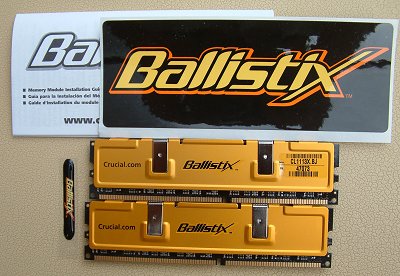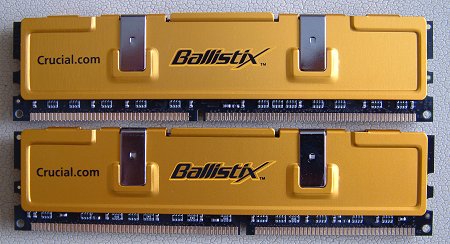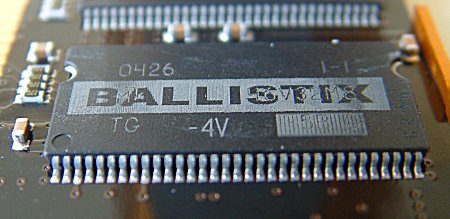Appearance and thoughts
Crucial's range of high-performance Ballistix memory can be found here. We're taking a look at a 1GByte (2x512MB) of Ballistix PC4000 184-pin DDR1 memory. PC4000 and/or DDR500 both translate into memory running with a synchronous Front-Side Bus speed of 250MHz. That's 50MHz higher than both Intel and AMD's premium DDR1 chipsets currently officially cater for, yet we've seen a multitude of Intel S478 chipsets and select bus-locked S462 and S754 chipsets run past their rated speed with consummate ease.The market for such high-performance RAM is certainly there. Slower Intel Pentium 4 Northwood and Prescott processors often overclock by as much as 40% above nominal speeds. Most enthusiasts know Intel locks the multiplier on retail CPUs, so the only viable method of raising clock speed is to ramp up the CPU's Front-Side Bus. Carrying on the overclocked theme, a faster FSB is best fed by memory running in synchronous fashion. AMD's Athlon 64 range, when run with motherboard that supports bus-locking, can also use PC3200+ memory. The method of CPU-to-RAM communication is different from Intel's but the effect is the same - more bandwidth and lower latencies are good for performance.

I've delineated the need for speed. Here is Crucial's answer. The two test modules, both 512MB in size and PC4000 in specification, arrived with a funky Ballistix sticker, a smaller Ballistix badge and a perfunctory multi-language installation and warranty guide.

Taking a closer look at the modules shows that Crucial wants to separate its regular RAM from its Ballistix range in form, specification and price. Being a cynic and perhaps playing to the enthusiasts' notion of quality, Crucial straps good-looking aluminium heatspreaders on both sides. Crucial will undoubtedly argue that an operational 2.8v, 0.3v above the no-frills line, requires heatspreaders for efficient heat dispersal. It's a slight shame that it has needed to pump the voltage to match its competitors' DDR500 modules. Corsair, GeIL and OCZ, to be absolutely fair, do the same thing.

It's interesting to note that the heatspreaders don't convey the RAM's speed or timings, just a part number suffices. You'd think that serious speed promotion would be in order.
Heatspreaders are attached on via two clips and a thin layer of very sticky thermal tape.

If you enlarge the above picture you can just about make out Crucial's MT 46V32M8 TG -4V codes under the Ballistix name. That infers chip speed to be right on the DDR500 money, but further nomenclature on the lower right-hand side indicates -5B, or DDR400 speeds. It appears as if Crucial is happy, after testing, to brand these Ballistix modules at DDR500 speeds. I have no problem with which chips are used as long as rated specifications are met.
Interestingly, Crucial tests Ballistix DDRI modules in three separate Intel Canterwood (i875P) motherboards, with two from ABIT (IC7-MAX3, IC7-G) and one from ASUS (P4C800-E Deluxe). Modules are tested in dual-channel configuration, naturally, so one can assume they're matched pairs. It's a shame that a proven overclockable Athlon 64 setup isn't also used.
Official specifications
Latencies of 2.5-3-3-8 are a touch better than most of the competition's. However, it must be noted that other premium RAM manufacturers have now moved on to DDR1 modules running at 550MHz+.









